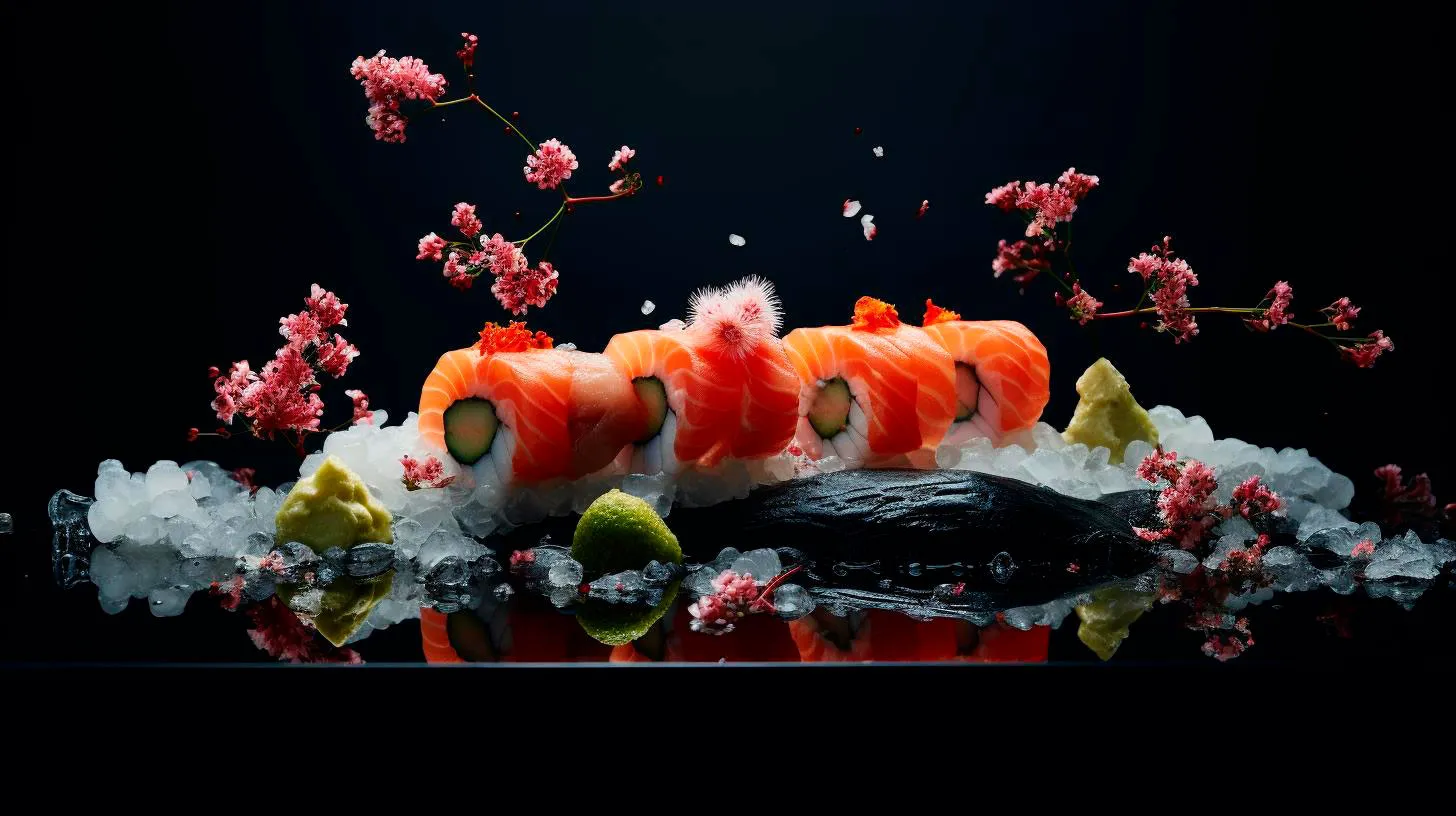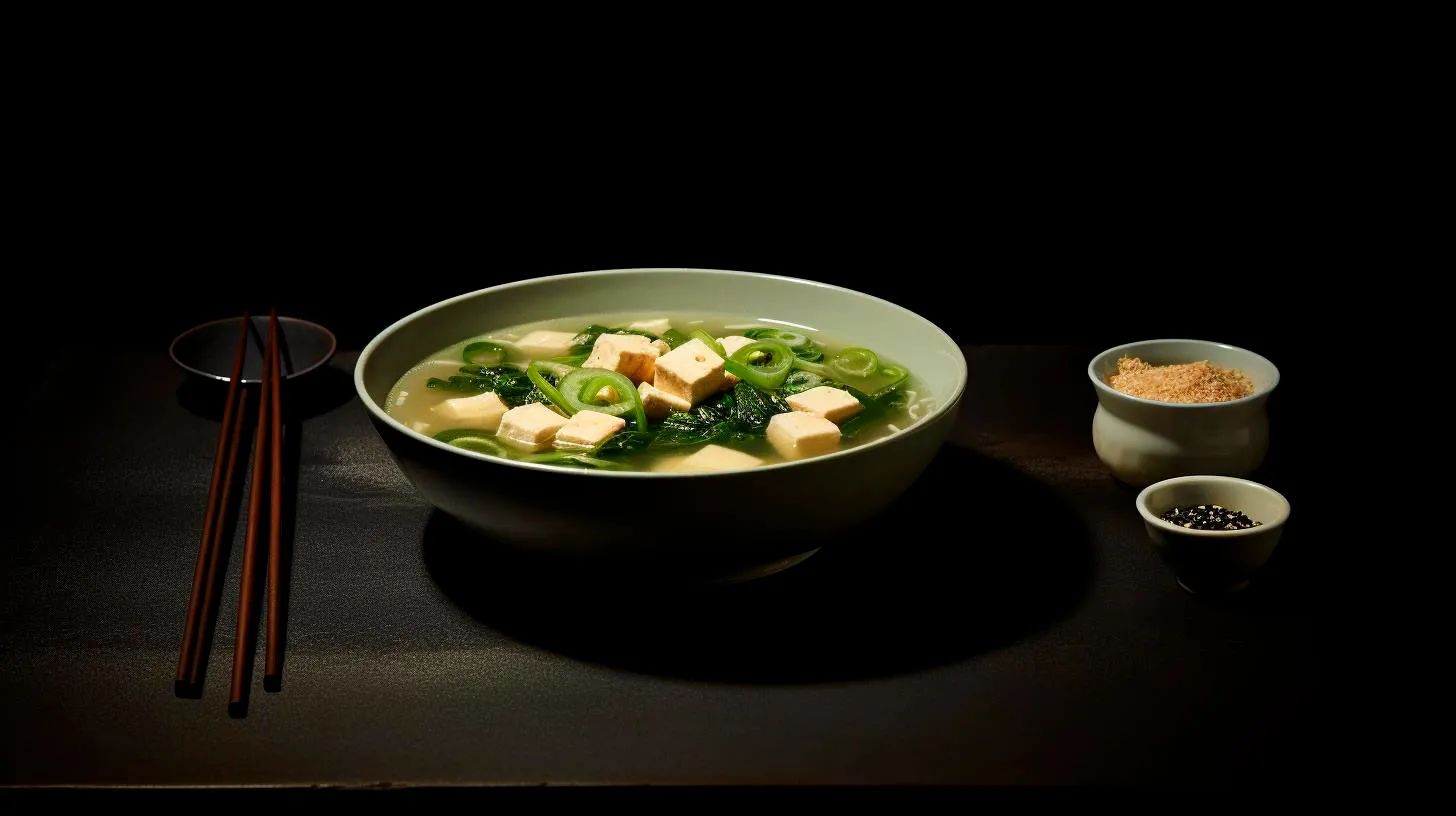Mastering the Art Sushi 101
In this article, we will delve into the basics of sushi, explore its various types, and discuss tips to help you become a sushi connoisseur. So grab your chopsticks and get ready to embark on a sushi adventure!
The Origins of Sushi
Before we dive into the technique of making sushi, it is important to understand its origins. Sushi, surprisingly, did not start in Japan as many might think. It actually originated in Southeast Asia, where fish was preserved by fermenting it with rice. This ancient method of preservation was brought to Japan in the 8th century, and over time, sushi evolved into the culinary delight we know and love today.
The Different Types of Sushi
Sushi comes in various forms, each with its unique taste and presentation. Here are some popular types of sushi you should know:
- Nigiri: Nigiri sushi consists of a small mound of rice topped with a slice of fish or seafood. It is a simple and classic sushi option.
- Maki: Maki sushi, also known as sushi rolls, involves rolling a layer of rice and ingredients in a sheet of seaweed. It is then cut into bite-sized pieces.
- Sashimi: Sashimi is not technically sushi as it does not include rice. It is thinly sliced raw fish or seafood served alone or garnished with herbs and soy sauce.
- Temaki: Temaki sushi is a hand-rolled cone of seaweed filled with rice, fish, and various fillings. It is a fun and customizable option.
Key Ingredients and Techniques
Now that we have covered the basics, let’s move on to the key ingredients and techniques that make sushi an art. The following are essential components for mastering sushi:
- Sushi Rice: Sushi rice is the foundation of every sushi dish. It is short-grain rice seasoned with vinegar, sugar, and salt. The texture and flavor of the rice are crucial to the overall taste of the sushi.
- Wasabi: Wasabi, a green spicy paste, is often served alongside sushi. Its distinctive flavor adds a kick to the sushi experience. Be cautious though, as wasabi can be quite potent!
- Soy Sauce: Soy sauce is a staple condiment in sushi dining. It is used for dipping sushi pieces and adds a savory flavor to enhance the taste of the fish or seafood.
- Sushi Knife: A sharp and precise sushi knife is essential for cutting through delicate ingredients and creating beautifully crafted sushi pieces.
Now that you are aware of the key ingredients, let’s explore some techniques that will elevate your sushi-making skills:
- Sushi Rolling: Properly rolling sushi involves spreading a thin layer of rice on a sheet of seaweed, adding fillings, and tightly rolling the sushi with a bamboo sushi mat. Practice makes perfect!
- Knife Skills: Mastering the art of slicing sushi takes time and practice. A sharp knife and a gentle hand are necessary to ensure clean, even cuts.
- Presentation: Sushi is not only about taste but also about presentation. Attention to detail, such as arranging the sushi on a beautiful plate and garnishing with precision, adds to the overall dining experience.
Advantages of Learning to Make Sushi
Learning the art of sushi-making has a myriad of advantages that extend beyond the sheer enjoyment of eating sushi. Here are some key advantages:
- Health Benefits: Sushi is a healthy choice for those looking to indulge in a delicious meal while maintaining a balanced diet. It is low in saturated fats and high in omega-3 fatty acids.
- Cultural Connection: By learning to make sushi, you can deepen your connection to Japanese culture and gain a deeper appreciation for the traditions and techniques passed down over generations.
- Creative Outlet: Sushi-making allows you to unleash your creativity as you experiment with different flavor combinations, colors, and presentations. Express yourself through sushi!
- Social Bonding: Hosting a sushi night with friends or family can be a delightful and interactive experience. It brings people together to create and enjoy a shared meal.
Key Takeaways
Sushi-making is an art that can be mastered with practice, patience, and a love for culinary creativity. Here are the key takeaways:
- Understand the origins and types of sushi to appreciate the rich history behind this culinary delight.
- Familiarize yourself with the key ingredients and techniques for sushi-making.
- Practice sushi rolling, knife skills, and presentation to create visually appealing and delicious sushi.
- Enjoy the health benefits, cultural connection, and creative outlet that come with learning to make sushi.
Now that you have a basic understanding of sushi, it’s time to embark on your sushi-making journey! Gather the necessary ingredients, practice your techniques, and let your creativity soar. Remember, sushi is not just a meal; it is an experience to be savored and enjoyed!
A Beginner Guide to Sushi Selection
In this article, we will walk you through everything you need to know to make informed sushi choices. So, let’s dive right in!
Understanding the Basic Types of Sushi
Before we explore the different types of sushi, let’s quickly understand the basic sushi terminology:
- Nigiri: Hand-pressed sushi consisting of a small mound of rice topped with seafood or fish slices.
- Maki: Rolled sushi wrapped in seaweed (nori) with rice and various fillings rolled using a bamboo mat.
- Sashimi: Sliced raw fish or seafood served without rice.
Now, let’s move on to exploring the most popular sushi varieties:
1. Maguro (Tuna)
Maguro, known as the king of sushi, is immensely popular worldwide. It is characterized by its vibrant red color and tender texture. Key takeaways:
- High in omega-3 fatty acids and protein.
- Considered one of the healthiest forms of sushi.
- Try different cuts of Maguro, such as Akami (lean), Chutoro (medium fatty), and Otoro (fatty) to experience diverse flavors.
2. Sake (Salmon)
Sake, another beloved sushi fish, offers a rich and buttery taste. Here are some points to note:
- Rich in omega-3 fatty acids and vitamin D.
- Provides a smooth and velvety texture.
- Perfect for those starting their sushi journey as it has a milder flavor compared to other fish.
3. Hamachi (Yellowtail)
Hamachi, with its delicate flavor and buttery texture, is a must-try for sushi enthusiasts. Explore these key features:
- Excellent source of high-quality protein.
- Offers a buttery and rich taste with a hint of sweetness.
- Enjoy it as sashimi to savor its full flavor or in rolls for a delightful combination.
4. Ebi (Shrimp)
For those seeking a cooked sushi option, Ebi is a popular choice. Consider the following when selecting Ebi sushi:
- Low in calories and packed with protein.
- Deliciously sweet and succulent in taste.
- Pair it with a spicy mayo sauce or enjoy it tempura-style for a crispy twist.
5. Unagi (Freshwater Eel)
Unagi, often found in sushi rolls, is unique and offers a delightful flavor. Take note of the following points:
- Rich in omega-3 fatty acids and vitamins.
- Provides a slightly sweet and smoky taste.
- Typically enjoyed grilled or barbecued and glazed with a sweet sauce.
Choosing the Right Sushi
As a beginner, it’s essential to choose sushi wisely to have an enjoyable experience. Here are a few tips:
- Start with milder options like salmon or shrimp before exploring stronger flavors like tuna.
- Opt for fresh fish from reputable sushi establishments to ensure quality.
- Consider trying a sushi platter to experience a variety of flavors and textures.
- Don’t hesitate to ask the sushi chef for recommendations based on your preferences.
The Importance of Wasabi, Soy Sauce, and Ginger
When enjoying sushi, understanding the role of condiments plays a crucial part in enhancing your experience:
- Wasabi: A green paste with a pungent flavor, wasabi adds heat and a unique taste to sushi. Use it sparingly to avoid overpowering the delicate flavors.
- Soy Sauce: Dip your sushi lightly in soy sauce to add a savory element. Remember not to soak the rice as it can make it fall apart.
- Ginger: The pickled ginger serves as a palate cleanser between different sushi bites. Take a small piece between each type to refresh your taste buds.
A Sushi Adventure Awaits
Now that you have a basic understanding of sushi selection, it’s time to embark on your sushi adventure. Remember to choose high-quality sushi, experiment with different flavors, and most importantly, enjoy the experience!
Whether you are a sushi aficionado or just starting your journey, sushi offers a fascinating world of flavors and textures. So take your time, savor each bite, and get ready to fall in love with this beloved Japanese delicacy!
From Chopsticks to Sake: Navigating Sushi Etiquette
The Importance of Proper Chopstick Etiquette
Chopsticks are the quintessential utensils used in Asian cuisines, including sushi. When dining on sushi, it’s crucial to observe proper chopstick etiquette to show respect for the chef and the culture. Here are some key points to remember:
- Using Chopsticks: Hold the chopsticks in your dominant hand, near the upper ends. Use your thumb and index finger to grip the chopsticks while using your ring finger to stabilize them. Avoid crossing the chopsticks or sticking them vertically into your rice, as these are considered disrespectful gestures.
- Soy Sauce Usage: When dipping your sushi into soy sauce, do it with care. It’s important to avoid soaking the rice, as this can overpower the delicate flavors. Instead, lightly dip the fish side of your sushi into the soy sauce to enhance the taste without overpowering it.
- Passing Food: If you’re sharing a plate of sushi with others, it’s customary to use the blunt ends of your chopsticks to pass a plate or piece of sushi to someone else. This is a polite way to share the delicious experience.
Sake and Sushi Pairings
When it comes to enhancing the flavors of your sushi, pairing it with the right sake can be a delightful experience. Consider these tips to elevate your sushi and sake pairing game:
- Junmai Daiginjo Sake: Known for its light and refined taste, Junmai Daiginjo sake is an excellent choice for subtle and delicate sushi flavors.
- Nigori Sake: This unfiltered sake variety has a milky appearance and a sweeter taste, making it a perfect match for sushi with slightly bolder flavors.
- Ginjo Sake: With a rich aroma and smooth finish, Ginjo sake complements a wide range of sushi, including both raw and cooked options.
Remember, selecting a sake that complements your sushi enhances the overall dining experience and allows the flavors to harmonize on your palate.
Respecting the Chef and the Atmosphere
When dining at a sushi restaurant, it’s important to respect the chef’s expertise and the overall atmosphere. Here are some essential points to keep in mind:
- Seating Etiquette: Unless directed otherwise, take the seat assigned or indicated by the staff. Sitting at the sushi bar allows you to witness the chef’s craft and experience the artistry behind each piece you consume.
- Ordering Sushi: It’s customary to start with lighter and more delicate flavors, gradually moving towards stronger and more robust ones. This progression allows you to savor each dish without overwhelming your taste buds.
- Engaging with the Chef: If you’re sitting at the sushi bar, interacting with the chef can provide valuable insights and enhance your dining experience. However, avoid excessive conversation and let the chef focus on preparing the sushi.
Key Takeaways
Navigating sushi etiquette ensures a respectful and immersive dining experience. Remember these key takeaways:
- Observe proper chopstick etiquette by holding them correctly and avoiding disrespectful gestures.
- Be mindful when using soy sauce to enhance the flavors without overpowering the delicate taste of the sushi.
- Explore different sake varieties to find the perfect pairing for your sushi.
- Show appreciation for the chef’s expertise by adhering to seating and ordering etiquettes.
- Interact with the chef when appropriate, but ensure they can focus on their craft.
By embracing sushi etiquette, you not only gain insights into the traditions and culture but also enhance your overall enjoyment of this exquisite cuisine. So, the next time you indulge in sushi, remember to respect the customs and savor every bite with appreciation!
Sushi Dos and Don’ts: Essential Etiquette Tips for Newbies
To ensure you have the best dining experience, we have compiled a list of essential dos and don’ts for sushi newbies.
The Dos
- Observe and learn: Before diving into the world of sushi, take some time to observe and learn from the experts. Watch how others eat and follow their lead when it comes to the proper way to hold chopsticks and use soy sauce.
- Use your hands: Contrary to popular belief, it is acceptable to eat sushi with your hands. However, be sure to use only your clean, washed hands and avoid touching the fish directly.
- Master chopsticks: If you prefer to use chopsticks, practice using them beforehand to achieve a confident grip. Remember to never leave your chopsticks sticking upright in the rice, as this is considered disrespectful.
- Properly dip in soy sauce: Dip your sushi into soy sauce fish-side down to savor the flavors without overpowering them. Avoid drenching your sushi and creating a messy experience.
- Enjoy in one bite: Sushi is typically meant to be consumed in one bite. It allows you to experience the harmony of flavors and textures created by the chef. Avoid biting or cutting sushi into smaller pieces, as it disrupts the intended balance.
- Appreciate the ginger: Pickled ginger is provided as a palate cleanser between sushi pieces. Use it sparingly to refresh your taste buds and cleanse your palate.
The Don’ts
- Don’t use too much wasabi: Unless you have a high tolerance for spiciness, use wasabi sparingly. Authentic sushi chefs usually place the right amount of wasabi on the sushi, and adding extra may overpower the flavors.
- Avoid mixing wasabi and soy sauce: Combining wasabi and soy sauce can alter the delicate taste of the sushi. Instead, apply wasabi directly on top of the fish or lightly dip the fish in soy sauce.
- Refrain from rubbing hashi (chopsticks) together: While rubbing chopsticks together is a common practice, it is considered impolite in higher-end sushi establishments. Trust that the sushi chef has provided you with quality chopsticks.
- Don’t order everything at once: Sushi is best enjoyed as it is served. Trust the chef’s choice and order dishes in small portions to fully appreciate each piece.
- Avoid drowning the sushi in soy sauce: Applying excessive soy sauce to your sushi might disrespect the chef’s culinary artistry. The sushi should be enhanced by the soy sauce, not soaked in it.
- Don’t mix up the order: Eating sushi is a culinary journey carefully curated by the chef. Avoid consuming nigiri and sashimi back to back or mixing the predetermined order of the chef’s omakase.
By adhering to these sushi dos and don’ts, you can demonstrate your respect for the art of sushi-making and enjoy an authentic dining experience. Remember, etiquette plays a crucial role in Japanese culture, and embracing it adds to the overall experience of indulging in this exquisite cuisine.
Key Takeaways:
- Observe and learn from experienced sushi eaters to understand the proper etiquette.
- Eating sushi with your hands is acceptable, as is using chopsticks.
- Dip your sushi fish-side down into soy sauce to maintain the delicate balance of flavors.
- Enjoy each piece of sushi in one bite to experience the full flavor.
- Use wasabi sparingly and avoid mixing it with soy sauce.
- Refrain from rubbing chopsticks together and order dishes in small portions.
- Respect the chef’s choices and avoid drenching sushi in soy sauce.
- Follow the predetermined order of the chef’s omakase.
With these essential sushi etiquette tips in mind, you can confidently embark on your culinary adventure and fully appreciate the art of sushi-making.



